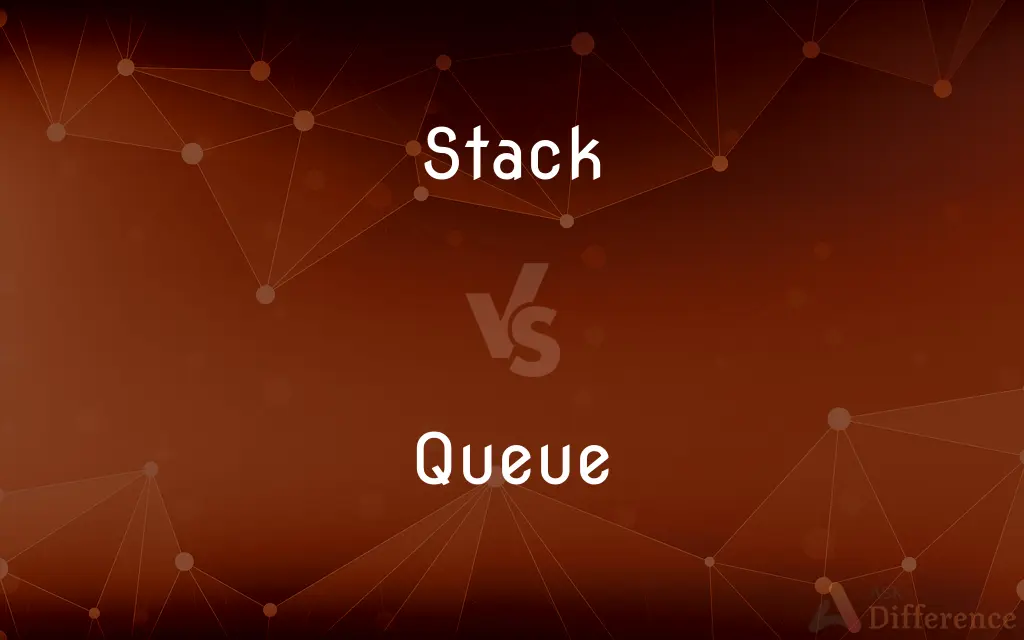Stack vs. Queue — What's the Difference?
By Fiza Rafique & Maham Liaqat — Updated on May 15, 2024
A stack is a data structure that follows Last In, First Out (LIFO) order, while a queue follows First In, First Out (FIFO) order.

Difference Between Stack and Queue
Table of Contents
ADVERTISEMENT
Key Differences
A stack is a linear data structure that operates on a Last In, First Out (LIFO) principle. This means the last element added to the stack is the first one to be removed. Stacks are commonly used in scenarios like function call management and undo mechanisms in software applications. On the other hand, a queue operates on a First In, First Out (FIFO) principle, where the first element added is the first one to be removed.
While stacks use operations such as push (add an item) and pop (remove an item), queues use enqueue (add an item) and dequeue (remove an item). The order of operations is critical in both structures but follows different principles.
Stacks maintain a single point of access (the top), allowing operations only at one end. Queues have two points of access, allowing insertion at the rear and removal at the front.
In memory usage, stacks are often implemented using arrays or linked lists, which provide efficient access and manipulation of elements. Queues can also be implemented using arrays or linked lists but may additionally use circular buffers to optimize space usage.
Stacks are beneficial for depth-first traversal algorithms, whereas queues are suited for breadth-first traversal algorithms. Each data structure's unique properties make it suitable for different types of problems.
ADVERTISEMENT
Comparison Chart
Order of Operations
Last In, First Out (LIFO)
First In, First Out (FIFO)
Primary Operations
Push (add), Pop (remove)
Enqueue (add), Dequeue (remove)
Access Points
Single (top)
Two (front and rear)
Common Uses
Function calls, undo mechanisms
Task scheduling, request management
Memory Implementation
Arrays, linked lists
Arrays, linked lists, circular buffers
Traversal Suitability
Depth-first traversal
Breadth-first traversal
Compare with Definitions
Stack
Supports push and pop operations.
When an item is popped, it is removed from the top of the stack.
Queue
Supports enqueue and dequeue operations.
When an item is dequeued, it is removed from the front of the queue.
Stack
Enables undo mechanisms in applications.
Each action in the editor is pushed onto the undo stack.
Queue
A linear data structure with FIFO order.
The queue processes items in the order they were added.
Stack
An orderly pile, especially one arranged in layers
A stack of newspapers.
Queue
Manages requests in web servers.
Incoming requests are placed in a queue and processed sequentially.
Stack
A large, usually conical pile of straw or fodder arranged for outdoor storage.
Queue
Accessible from both front and rear.
You enqueue items at the rear and dequeue from the front.
Stack
(Computers) A section of memory and its associated registers used for temporary storage of information in which the item most recently stored is the first to be retrieved.
Queue
A line or sequence of people or vehicles awaiting their turn to be attended to or to proceed.
Stack
A group of three rifles supporting each other, butt downward and forming a cone.
Queue
A list of data items, commands, etc., stored so as to be retrievable in a definite order, usually the order of insertion.
Stack
A chimney or flue.
Queue
A plait of hair worn at the back.
Stack
A group of chimneys arranged together.
Queue
Take one's place in a queue
In the war they had queued for food
Stack
A vertical exhaust pipe, as on a ship or locomotive.
Queue
Arrange in a queue
Input or output requests to a file are queued by the operating system
Stack
An extensive arrangement of bookshelves.
Queue
A line of waiting people or vehicles.
Stack
The area of a library in which most of the books are shelved.
Queue
A sequence of stored data or programs awaiting processing.
Stack
A stackup.
Queue
A data structure from which the first item that can be retrieved is the one stored earliest.
Stack
An English measure of coal or cut wood, equal to 108 cubic feet (3.06 cubic meters).
Queue
A long braid of hair worn hanging down the back of the neck; a pigtail.
Stack
(Informal) A large quantity
A stack of work to do.
Queue
To get in line
Queue up at the box office.
Stack
To arrange in a stack; pile.
Queue
To place in a sequence
Queued the queries in order of relevance.
Stack
To load or cover with stacks or piles
Stacked the dishwasher.
Queue
To braid or twist (hair) into a queue.
Stack
(Games) To prearrange the order of (a deck of cards) so as to increase the chance of winning.
Queue
A line of people, vehicles or other objects, in which one at the front end is dealt with first, the one behind is dealt with next, and so on, and which newcomers join at the opposite end (the back).
Stack
To prearrange or fix unfairly so as to favor a particular outcome
Tried to stack the jury.
Queue
A waiting list or other means of organizing people or objects into a first-come-first-served order.
Stack
To direct (aircraft) to circle at different altitudes while waiting to land.
Queue
(computing) A data structure in which objects are added to one end, called the tail, and removed from the other, called the head (in the case of a FIFO queue). The term can also refer to a LIFO queue or stack where these ends coincide.
Stack
To form a stack
Make sure the boxes stack neatly against the wall.
Queue
(heraldry) An animal's tail.
Stack
(heading) A pile.
Queue
A men's hairstyle with a braid or ponytail at the back of the head, such as that worn by men in Imperial China.
Stack
A large pile of hay, grain, straw, or the like, larger at the bottom than the top, sometimes covered with thatch.
Queue
(intransitive) To put oneself or itself at the end of a waiting line.
Stack
A pile of similar objects, each directly on top of the last.
Please bring me a chair from that stack in the corner.
Queue
(intransitive) To arrange themselves into a physical waiting queue.
Stack
(UK) A pile of poles or wood, indefinite in quantity.
Queue
To add to a queue data structure.
Stack
A pile of wood containing 108 cubic feet. (~3 m³)
Queue
To fasten the hair into a queue.
Stack
An extensive collection
Queue
A tail-like appendage of hair; a pigtail.
Stack
A smokestack.
Queue
To fasten, as hair, in a queue.
Stack
(heading) In computing.
Queue
A line of people or vehicles waiting for something
Stack
(programming) A linear data structure in which items inserted are removed in reverse order (the last item inserted is the first one to be removed).
History stack
Queue
(information processing) an ordered list of tasks to be performed or messages to be transmitted
Stack
A stack data structure stored in main memory that is manipulated during machine language procedure call related instructions.
Queue
A braid of hair at the back of the head
Stack
An implementation of a protocol suite (set of protocols forming a layered architecture).
A TCP/IP stack is a library or set of libraries or of OS drivers that take care of networking.
Queue
Form a queue, form a line, stand in line;
Customers lined up in front of the store
Stack
A combination of interdependent, yet individually replaceable, software components or technologies used together on a system.
Queue
Used in task scheduling.
The operating system uses a queue to manage processes waiting for execution.
Stack
(math) A generalization of schemes in algebraic geometry and of sheaves.
Stack
(geology) A coastal landform, consisting of a large vertical column of rock in the sea.
Stack
(library) Compactly spaced bookshelves used to house large collections of books.
Stack
(figuratively) A large amount of an object.
They paid him a stack of money to keep quiet.
Stack
(military) A pile of rifles or muskets in a cone shape.
Stack
(poker) The amount of money a player has on the table.
Stack
(heading) In architecture.
Stack
A number of flues embodied in one structure, rising above the roof.
Stack
A vertical drainpipe.
Stack
A fall or crash, a prang.
Stack
(bodybuilding) A blend of various dietary supplements or anabolic steroids with supposed synergistic benefits.
Stack
(aviation) A holding pattern, with aircraft circling one above the other as they wait to land.
Stack
(video games) The quantity of a given item which fills up an inventory slot or bag.
I've got 107 Golden Branches, but the stack size is 20 so they're taking up 6 spaces in my inventory.
Stack
(transitive) To arrange in a stack, or to add to an existing stack.
Please stack those chairs in the corner.
Stack
To arrange the cards in a deck in a particular manner.
This is the third hand in a row where you've drawn four of a kind. Someone is stacking the deck!
Stack
To take all the money another player currently has on the table.
I won Jill's last $100 this hand; I stacked her!
Stack
(transitive) To deliberately distort the composition of (an assembly, committee, etc.).
The Government was accused of stacking the parliamentary committee.
Stack
To crash; to fall.
Jim couldn′t make it today as he stacked his car on the weekend.
Stack
(gaming) To operate cumulatively.
A magical widget will double your mojo. And yes, they do stack: if you manage to get two magical widgets, your mojo will be quadrupled. With three, it will be octupled, and so forth.
Stack
To place (aircraft) into a holding pattern.
Stack
To collect precious metal in the form of various small objects such as coins and bars.
Stack
(printing) To have excessive ink transfer.
Stack
A large and to some degree orderly pile of hay, grain, straw, or the like, usually of a nearly conical form, but sometimes rectangular or oblong, contracted at the top to a point or ridge, and sometimes covered with thatch.
But corn was housed, and beans were in the stack.
Stack
An orderly pile of any type of object, indefinite in quantity; - used especially of piles of wood. A stack is usually more orderly than a pile
Against every pillar was a stack of billets above a man's height.
Stack
A pile of wood containing 108 cubic feet.
Stack
A large quantity; as, a stack of cash.
Stack
A number of flues embodied in one structure, rising above the roof.
Stack
A section of memory in a computer used for temporary storage of data, in which the last datum stored is the first retrieved.
Stack
The section of a library containing shelves which hold books less frequently requested.
Stack
To lay in a conical or other pile; to make into a large pile; as, to stack hay, cornstalks, or grain; to stack or place wood.
Stack
To place in a vertical arrangement so that each item in a pile is resting on top of another item in the pile, except for the bottom item; as, to stack the papers neatly on the desk; to stack the bricks.
Stack
To select or arrange dishonestly so as to achieve an unfair advantage; as, to stack a deck of cards; to stack a jury with persons prejudiced against the defendant.
Stack
An orderly pile
Stack
(often followed by `of') a large number or amount or extent;
A batch of letters
A deal of trouble
A lot of money
He made a mint on the stock market
It must have cost plenty
Stack
A list in which the next item to be removed is the item most recently stored (LIFO)
Stack
A large tall chimney through which combustion gases and smoke can be evacuated
Stack
A storage device that handles data so that the next item to be retrieved is the item most recently stored (LIFO)
Stack
Load or cover with stacks;
Stack a truck with boxes
Stack
Arrange in stacks;
Heap firewood around the fireplace
Stack your books up on the shelves
Stack
Arrange the order of so as to increase one's winning chances;
Stack the deck of cards
Stack
A linear data structure with LIFO order.
The stack allows pushing elements onto the top.
Stack
Used in function call management.
The stack keeps track of active function calls in the program.
Stack
Accessible only from the top.
You can only add or remove elements from the top of the stack.
Common Curiosities
How does a queue operate?
A queue operates on the First In, First Out (FIFO) principle.
Where are stacks commonly used?
Stacks are used in function call management and undo mechanisms.
What is the benefit of a stack in algorithm design?
Stacks are beneficial for depth-first traversal algorithms.
Can a queue be implemented using arrays?
Yes, queues can be implemented using arrays, linked lists, or circular buffers.
What happens when you pop from an empty stack?
Popping from an empty stack typically causes an underflow error.
What is the main principle of a stack?
A stack follows the Last In, First Out (LIFO) principle.
What are the primary operations of a stack?
Push (add an item) and pop (remove an item).
Where are queues commonly used?
Queues are used in task scheduling and request management.
Can a stack be implemented using arrays?
Yes, stacks can be implemented using arrays or linked lists.
What happens when you dequeue from an empty queue?
Dequeueing from an empty queue typically causes an underflow error.
What are the primary operations of a queue?
Enqueue (add an item) and dequeue (remove an item).
How is access managed in a stack?
Access is only from the top of the stack.
How is access managed in a queue?
Access is from both the front (dequeue) and rear (enqueue) of the queue.
What is the benefit of a queue in algorithm design?
Queues are suited for breadth-first traversal algorithms.
Share Your Discovery

Previous Comparison
Social vs. Societal
Next Comparison
Adjoining vs. AdjacentAuthor Spotlight
Written by
Fiza RafiqueFiza Rafique is a skilled content writer at AskDifference.com, where she meticulously refines and enhances written pieces. Drawing from her vast editorial expertise, Fiza ensures clarity, accuracy, and precision in every article. Passionate about language, she continually seeks to elevate the quality of content for readers worldwide.
Co-written by
Maham Liaqat













































